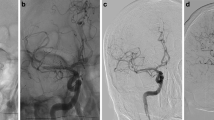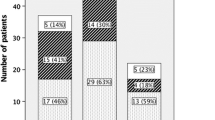Abstract
Background and Purpose
To describe our first experience using a small stent retriever specifically designed for thrombectomy in cerebral arteries with a small caliber (Acandis APERIO® 3.5/28) in patients with acute ischemic stroke.
Materials and Methods
All patients with an acute ischemic stroke, who underwent endovascular recanalization using the APERIO® thrombectomy device with a diameter of 3.5 mm, were identified in retrospect and included in the present analysis. Demographic and clinical data as well as data on the procedures performed were collected (patient sex, mean age, NIHSS, mRS, TICI score, and complications).
Results
Stent retriever-based thrombectomy with the Aperio® 3.5/28 alone (n = 10 vessels) or in combination with other devices (n = 13 vessels) was performed in 22 acute stroke patients with embolic occlusions of distal branches of the anterior and posterior circulations (median NIHSS = 8.5). For vessels treated with the Aperio® 3.5/28, we achieved a TICI 2b/3 reperfusion rate of 73.9%. One patient suffered a symptomatic intracerebral hemorrhage after thrombectomy; otherwise, no procedure-related complications were seen.
Conclusion
Our data suggest that mechanical thrombectomy of distal cerebral artery occlusions with the Aperio® 3.5/28 is feasible and in general safe, thus offering a promising option for endovascular stroke therapy. However, multicentric studies with larger patient cohorts are necessary to evaluate the clinical benefit.



Similar content being viewed by others
References
Goyal M, Menon BK, van Zwam WH, Dippel DW, Mitchell PJ, Demchuk AM, et al. Endovascular thrombectomy after large-vessel ischaemic stroke: a meta-analysis of individual patient data from five randomised trials. Lancet. 2016;387(10029):1723–31. https://doi.org/10.1016/S0140-6736(16)00163-X.
Berkhemer OA, Fransen PS, Beumer D, van den Berg LA, Lingsma HF, Yoo AJ, et al. A randomized trial of intraarterial treatment for acute ischemic stroke. N Engl J Med. 2015;372(1):11–20. https://doi.org/10.1056/NEJMoa1411587.
Goyal M, Demchuk AM, Menon BK, Eesa M, Rempel JL, Thornton J, et al. Randomized assessment of rapid endovascular treatment of ischemic stroke. N Engl J Med. 2015;372(11):1019–30. https://doi.org/10.1056/NEJMoa1414905.
Saver JL, Goyal M, Bonafe A, Diener HC, Levy EI, Pereira VM, et al. Stent-retriever thrombectomy after intravenous t-PA versus t-PA alone in stroke. N Engl J Med. 2015;372(24):2285–95. https://doi.org/10.1056/NEJMoa1415061.
Campbell BC, Mitchell PJ, Kleinig TJ, Dewey HM, Churilov L, Yassi N, et al. Endovascular therapy for ischemic stroke with perfusion-imaging selection. N Engl J Med. 2015;372(11):1009–18. https://doi.org/10.1056/NEJMoa1414792.
Jovin TG, Chamorro A, Cobo E, de Miquel MA, Molina CA, Rovira A, et al. Thrombectomy within 8 h after symptom onset in ischemic stroke. N Engl J Med. 2015;372(24):2296–306. https://doi.org/10.1056/NEJMoa1503780.
Coutinho JM, Liebeskind DS, Slater LA, Nogueira RG, Baxter BW, Levy EI, et al. Mechanical thrombectomy for isolated M2 occlusions: a post hoc analysis of the STAR, SWIFT, and SWIFT PRIME studies. AJNR Am J Neuroradiol. 2016;37(4):667–72. https://doi.org/10.3174/ajnr.A4591.
Kuhn AL, Wakhloo AK, Lozano JD, Massari F, De Macedo RK, Marosfoi MG, et al. Two-year single-center experience with the ‘Baby Trevo’ stent retriever for mechanical thrombectomy in acute ischemic stroke. J Neurointerv Surg. 2017;9(6):541–6. https://doi.org/10.1136/neurintsurg-2016-012454.
Kurre W, Aguilar-Perez M, Martinez-Moreno R, Schmid E, Bazner H, Henkes H. Stent retriever thrombectomy of small caliber intracranial vessels using pREset LITE: safety and efficacy. Clin Neuroradiol. 2016. https://doi.org/10.1007/s00062-016-0497-0.
Dorn F, Lockau H, Stetefeld H, Kabbasch C, Kraus B, Dohmen C, et al. Mechanical thrombectomy of M2-occlusion. J Stroke Cerebrovasc Dis. 2015;24(7):1465–70. https://doi.org/10.1016/j.jstrokecerebrovasdis.2015.04.013.
Navia P, Larrea JA, Pardo E, Arce A, Martinez-Zabaleta M, Diez-Gonzalez N, et al. Initial experience using the 3MAX cerebral reperfusion catheter in the endovascular treatment of acute ischemic stroke of distal arteries. J Neurointerv Surg. 2016;8(8):787–90. https://doi.org/10.1136/neurintsurg-2015-011798.
Premat K, Bartolini B, Baronnet-Chauvet F, Shotar E, Degos V, Muresan P, et al. Single-center experience using the 3MAX reperfusion catheter for the treatment of acute ischemic stroke with distal arterial occlusions. Clin Neuroradiol. 2017. https://doi.org/10.1007/s00062-017-0594-8.
Wenger KJ, Berkefeld J, Wagner M. Flat panel detector computed tomography for the interaction between contrast-enhanced thrombi and stent retrievers in stroke therapy: a pilot study. Clin Neuroradiol. 2014;24(3):251–4. https://doi.org/10.1007/s00062-013-0246-6.
Saqqur M, Uchino K, Demchuk AM, Molina CA, Garami Z, Calleja S, et al. Site of arterial occlusion identified by transcranial Doppler predicts the response to intravenous thrombolysis for stroke. Stroke. 2007;38(3):948–54. https://doi.org/10.1161/01.STR.0000257304.21967.ba.
Wenger K, Nagl F, Wagner M, Berkefeld J. Improvement of stent retriever design and efficacy of mechanical thrombectomy in a flow model. Cardiovasc Intervent Radiol. 2013;36(1):192–7. https://doi.org/10.1007/s00270-012-0420-2.
Rai AT, Hogg JP, Cline B, Hobbs G. Cerebrovascular geometry in the anterior circulation: an analysis of diameter, length and the vessel taper. J Neurointerv Surg. 2013;5(4):371–5. https://doi.org/10.1136/neurintsurg-2012-010314.
Rai AT, Rodgers D, Williams EA, Hogg JP. Dimensions of the posterior cerebral circulation: an analysis based on advanced non-invasive imaging. J Neurointerv Surg. 2013;5(6):597–600. https://doi.org/10.1136/neurintsurg-2012-010549.
Ring BA, Waddington MM. Intraluminal diameters of the intracranial arteries. Vasc Surg. 1967;1(3):137–51.
Author information
Authors and Affiliations
Corresponding author
Ethics declarations
Conflict of interest
Dr. Müller-Eschner has nothing to disclose. Dr. You has nothing to disclose. Dr. Jahnke has nothing to disclose. Dr. Kammerer has nothing to disclose. Dr. Foerch reports personal fees from Boehringer Ingelheim (honorarium) and Prediction Bioscience (honorarium), outside the submitted work. Dr. Pfeilschifter reports grants and personal fees from Stryker Neurovascular, grants and personal fees from Boehringer Ingelheim, personal fees from Sanofi-Aventis, grants from Novartis, outside the submitted work. Dr. Lauer has nothing to disclose. Dr. Berkefeld reports personal fees from Member of the scientific advisory board of Acandis, Pforzheim, Germany, other from Scientific cooperation with Siemens healthcare, Forchheim, Germany, outside the submitted work. Dr. Wagner reports personal fees from Acandis GmbH, during the conduct of the study.
Ethical Approval
For this type of study, formal consent is not required. This retrospective case series analysis was approved by the institutional review board.
Informed Consent
For this type of study, informed consent is not required.
Consent for Publication
For this type of study, consent for publication is not required.
Rights and permissions
About this article
Cite this article
Müller-Eschner, M., You, SJ., Jahnke, K. et al. Introducing the New 3.5/28 Microstent Retriever for Recanalization of Distal Cerebral Arteries in Acute Stroke: Preliminary Results. Cardiovasc Intervent Radiol 42, 101–109 (2019). https://doi.org/10.1007/s00270-018-2039-4
Received:
Accepted:
Published:
Issue Date:
DOI: https://doi.org/10.1007/s00270-018-2039-4




